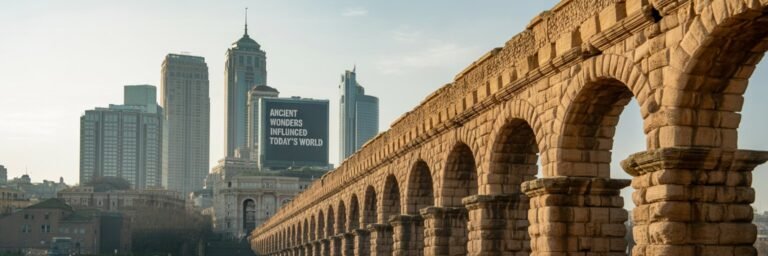INTRODUCTION
In the realm of human history, there exists an epoch of time scattered with immense feats of architectural prowess and engineering that bear testament to the genius of ancient civilizations. These structures, often dubbed ‘ancient wonders’, are characterized by their grand scale, unique design, and the depth of mystery that surrounds their construction and purpose. The Great Pyramid of Giza, Stonehenge, the Moai of Easter Island, the city of Machu Picchu – each a marvel that has aroused intense debate and speculation. This article seeks to unravel the enigmatic tapestry that swathes these ancient wonders, examining their historical background, delving into theories and interpretations surrounding them, unmasking controversies, analyzing symbolism and cultural significance, and conducting a review of modern investigations and their enduring legacy.
HISTORICAL BACKGROUND
Spanning across continents, these ancient wonders contour the tableau of humanity’s past, with constructions dating back to as early as 2500 BCE. The Great Pyramid of Giza, the oldest of these structures, is the only surviving wonder of the Seven Wonders of the Ancient World. Constructed during Egypt’s Old Kingdom under Pharaoh Khufu’s reign, the pyramid was the tallest man-made structure for nearly 4,000 years.
Moving onto the British Isles, the formation of Stonehenge, a circular arrangement of colossal stones in Wiltshire, England, was initiated around 3000 BCE. Renowned as a marvel of prehistoric engineering, its construction spanned centuries.
Crossing over to a remote island in the Pacific, the Moai, monolithic human figures carved by the Rapa Nui people of Easter Island, lend their eerie presence, with most erected between 1250 and 1500 CE.
High in the Andes, the city of Machu Picchu in Peru, built in the 15th century during the height of the Inca Empire, remained hidden from the Western world until its discovery in 1911 by Hiram Bingham.
THEORIES AND INTERPRETATIONS
Enigma surrounds these ancient wonders, with academics and enthusiasts alike offering a kaleidoscope of theories and interpretations to fill the gaps in our knowledge. The purpose of the Great Pyramid of Giza has traditionally been interpreted as a tomb for Pharaoh Khufu. However, some hypothesize that it served as a form of an astronomical observatory or a granary.
Stonehenge’s purpose remains even more elusive. It is generally agreed that it had a religious function, possibly related to solar and lunar cycles. Some speculate that it functioned as a celestial calendar, while others theorize that it acted as a burial ground or a healing site.
The Moai of Easter Island have been considered ancestral representations or religious idols, with recent theories proposing they marked sources of freshwater.
In contrast, the function of Machu Picchu is clearer. As a royal estate for the Inca emperor, it has also been theorized as a sacred ceremonial site or a secluded retreat for the Inca elite.
MYSTERIES AND CONTROVERSIES
Notwithstanding the impressive theories, controversies persist. The Pyramids’ precision and scale have spawned fringe theories, ranging from extraterrestrial constructors to lost technologies of advanced ancient civilizations.
Stonehenge’s mystery isn’t just its purpose, but also how Neolithic people transported bluestones over 200 miles from Wales. Various theories, including glacial transport and human effort using sledges, have been suggested to solve this quandary.
The mystery of how the Rapa Nui people erected the massive Moai statues, some weighing up to 82 tons, continues to generate debates involving ropes, ramps or rockers.
As for Machu Picchu, controversy swirls around its ‘discovery’ by Bingham, with evidence suggesting that locals knew of its existence much earlier.
SYMBOLISM AND CULTURAL SIGNIFICANCE
These wonders were more than just stones poised in gravity-defying formations; they were symbolic manifestations of cultures and beliefs. The Great Pyramid symbolized Pharaoh’s divine power and spiritual ascension, while Stonehenge played a crucial role in ancient Neolithic cosmology.
The Moai statues are thought to have been symbols of authority and power, both religious and political.
For the Incas, Machu Picchu remained a sacred landscape intimately tied to their Andean cosmology.
MODERN INVESTIGATIONS
Modern tools, including ground-penetrating radar and space-based laser mapping, are shedding new light on these structures. The ScanPyramids project has provided evidence for a ‘Big Void’ inside the Great Pyramid, while LiDAR technology has revealed new stones and pits at Stonehenge.
On Easter Island, scientific studies have verified the ‘walked’ method of Moai transportation, while aerial drones and 3D scanning at Machu Picchu have unveiled new aspects of Inca architecture and water management.
LEGACY AND CONCLUSION
The enduring legacy of these wonders lies not only in their physical structures but also in the intellectual giants they continue to engender. They inspire global curiosity and encourage us to dig deeper into our past, fostering a greater understanding of the human journey.
In conclusion, these structures remind us of the extraordinary potential of human endeavor and creativity, demanding reverence for the civilizations that birthed them. They stand as cultural testament, providing valuable insights into ancient societies and underscoring the rich tapestry of human history. While imbued with enigma and fantasy, the experience of our forebears manifests evidently in these edifices, offering not only a perspective of primitive innovation but also an enlightened understanding of ourselves. As research goes on, let us hope more secrets buried within these ancient wonders gradually unravel, offering glimpses into the extraordinarily sophisticated minds of our predecessors.






